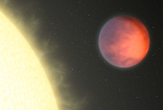Huge Alien Planet Has a Mysterious Hot Spot

A huge alien planet has a strange hot spot on its side, and astronomers aren't sure what to make of it.
The planet, named Upsilon Andromedae b, is a so-called "hot Jupiter" — a scorching gas giant. It is also tidally locked, meaning that one side is perpetually boiling under its parent star's fierce glare.
But the warmest part of the planet isn't this sun-baked face, according to a new study. A spot way over on the side of the planet is actually much hotter. [Illustration of the alien planet.]
"We really didn't expect to find a hot spot with such a large offset," said lead author Ian Crossfield, of the University of California, Los Angeles, in a statement. "It's clear that we understand even less about the atmospheric energetics of hot Jupiters than we thought we did."
Measuring light from faraway planets
Upsilon Andromedae b is about 44 light-years from Earth in the constellation Andromeda. The planet is about 70 percent as massive as Jupiter, and it whips around its star every 4.6 days or so, scientists said.
Crossfield and his team used NASA's infrared Spitzer Space Telescope to measure the total infrared light coming from the planet and its parent star over five days in February 2009.
Sign up for the Live Science daily newsletter now
Get the world’s most fascinating discoveries delivered straight to your inbox.
The Spitzer telescope cannot see the planet directly, but it can detect light variations that arise as the hot side of the planet comes into Earth's field of view. The hottest part of the planet will give off the most infrared light.
Conventional wisdom suggests that the star-planet system should appear brightest when the planet is directly behind the star, thus showing Spitzer its full sun-facing side.
But the system was brightest when the planet was to the side of the star, with its side facing Earth — meaning that Upsilon Andromedae b's hottest parts are not under the star's full glare.
Rethinking explanations
Observations of other hot Jupiters have shown that hot spots can be shifted to the side a little. Astronomers think that fierce winds may push hot gases around on such alien planets. But the new study found such a dramatic offset that other mechanisms are likely at work on Upsilon Andromedae b, scientists said.
Researchers have guessed at some possibilities, including supersonic winds triggering shock waves that heat material up, as well as star-planet magnetic interactions. But these are just speculation. As more hot Jupiters are examined, astronomers will test new theories.
"This is a very unexpected result," said Michael Werner, Spitzer project scientist at NASA's Jet Propulsion Laboratory in Pasadena, Calif., who was not involved in the study. "Spitzer is showing us that we are a long way from understanding these alien worlds." The study has been accepted for publication in the Astrophysical Journal.
- Gallery: The Strangest Alien Planets
- Top 10 Extreme Planet Facts
- Curtain to Lift on Alien Planets by the Hundreds
This article was provided by SPACE.com, a sister site of LiveScience.com.










